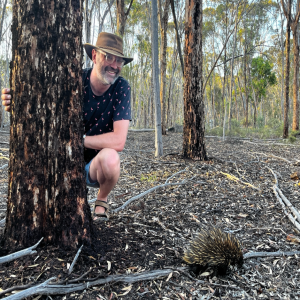Sensory and Developmental Neuroscience
Keays-Lab
Keays-Lab

© Carolin Bleese
The goal of the Keays lab is to answer important questions in sensory and developmental neuroscience. We do this by relying on creative experimental design, that is complemented by a reductionist mindset that pays unrelenting attention to detail.
We are focused on three questions:
In tackling these questions we adopt an inter-disciplinary approach employing a variety of model systems and state-of-the-art technologies. To explore how animals sense magnetic fields, we use pigeons as a model system utilising whole brain clearing, light-sheet microscopy, 2-photon calcium imaging, neuropixels, synchrotron based elemental imaging, and single cell sequencing. We hypothesis that pigeons detect magnetic fields by relying on electromagnetic induction within the inner ear which activates a defined neuronal circuirt within the central nervous system.
To gain insight into the genetic architecture required to build a vertebrate brain we rely on the generation of novel transgenic mouse mutants, and cerebral organoid technology alongside the study of human neurodevelopmental disorders. Our work has hilighted the importance of the tubulins and microtubule associated proteins (MAPs) for the generation, migration and differentiation of neurons.
Our current work is focused on disease causing mutations in a family of uncharacterised microtubule associated proteins (MAST1-4). We hypothesise that mutations in these genes cause disease by disrupting the neuronal phosphoproteome which compromises the microtubule cytoskeleton, altering the structure and/or function of cortical neurons.

To gain insight into the developmental principles that underlie the development of monotreme brains we have invested in iPSC based technology coupling it 3D cell culture methods. We work closely with Professor Frank Gutzer (University of Adelaide) and the Southern Koala and Echidna Rescue (SKER) with the aim of preserving cellular samples for the scientific community.
Our work is focused on the structural differences between the Echidna brain (which is highly gyrified) and the Platypus brain (which is smoooth). We hypothesise that these differences are attributable to a difference in the number, type, or output of neuronal progenitors.
Selected publications:
Keays DA, Tian G, Poirier K, Huang G, Siebold S, Cleak J, Oliver P, Washbourne R, Fray M, Harvey RJ, Molnar Z, Pinon M, Dear N, Brown SD, Rawlins JP, Davies KE, Cowan NJ, Patrick Nolan P, Chelly J, Flint J. Mutations in -tubulin cause defects in neuronal migration in mice and lissencephaly in humans. Cell. 2007 Jan 12;128(1):45-57.
Treiber CD, Salzer CM, Riegler J, Edelman N, Sugar C, Breuss M, Pichler P, Cadiou H, Saunders M, Lythgoe M, Shaw J, Keays DA. Clusters of iron rich cells in the upper beak of pigeons are macrophages not magnetosensitive neurons. Nature. 2012 Apr 11;484(7394):367-70.
Gstrein T, Edwards A, Přistoupilová A, Leca I, Breuss M, Pilat-Carotta S, Hansen AH, Tripathy R, Traunbauer AK, Hochstoeger T, Rosoklija G, Repic M, Landler L, Stránecký V, Dürnberger G, Keane TM, Zuber J, Adams DJ, Flint J, Honzik T, Gut M, Beltran S, Mechtler K, Sherr E, Kmoch S, Gut I, Keays DA. (2018). Mutations in Vps15 perturb neuronal migration in mice and are associated with neurodevelopmental disease in humans. Nat Neurosci. Feb;21(2):207-217.
Tripathy R, van Dijk T, van Bon B, Gstrein T, Bahi-Buisson N, Paciorkowski A, Pagnamenta A, Taylor J, Terrone G, Vitiello G, D’Amico A, Del Giudice E, Brunetti-Pierri N, Reymond A, Voisin N, Bernstein JA, Farrelly E, Pierson T, Kini U, Leonard T, Mirzaa G, Baas F, Chelly J, Keays DA Mutations in MAST1 cause mega corpus callosum syndrome and cortical malformations. Neuron, 2018 Dec 19;100(6):1354-1368.
Nimpf S, Nordmann GC, Kagerbauer D, Malkemper EP, Landler L, Papadaki-Anastasopoulou A, Ushakova L, Wenninger-Weinzierl A, Novatchkova M, Vincent P, Lendl T, Colombini M, Mason MJ, Keays DA. A putative mechanism for magnetoreception by electromagnetic induction in the pigeon inner ear. Current Biology. 2019 Dec 2;29(23):4052-4059.